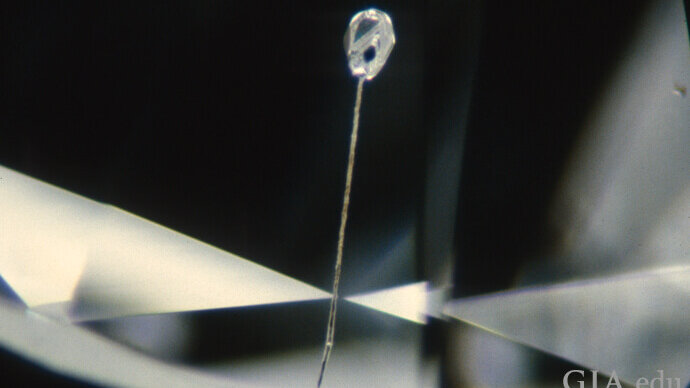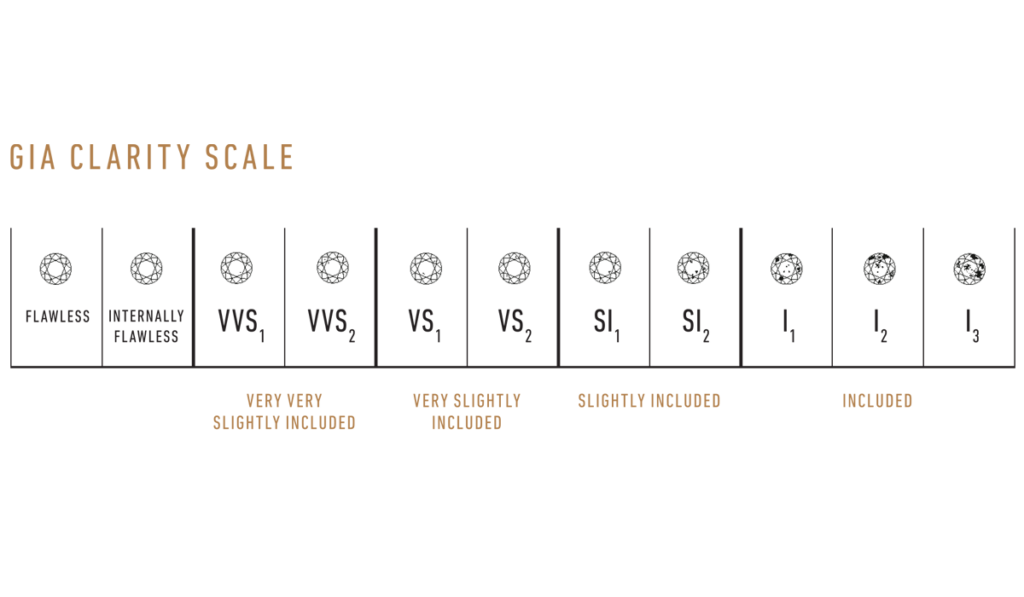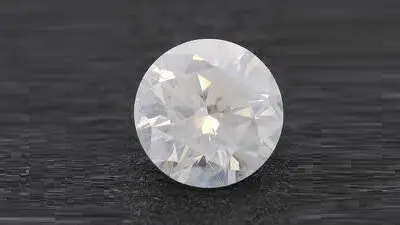Avoid These Diamond Inclusions at All Costs

By Gary A.

Edited by Olivia H.
Published Jul 28, 2022
Edited on Mar 31, 2025
When evaluating diamonds, knowing how to spot and assess diamond inclusions can make all the difference in finding a stone that looks flawless to the naked eye without overspending.

Navigate This Guide:
- 7 Quick Tips for Examining Diamond Clarity and Inclusions in Engagement Rings
- Introduction
- The Basics of Diamond Inclusions
- Types of Diamond Inclusions and Their Significance
- Navigating Diamond Clarity and Inclusions
- Identifying Problematic Inclusions and Evaluating Diamonds Beyond Certification
- Our Expert Take
- 10 Frequently Asked Questions about Diamond Inclusions
Before we dive deeper into the specifics, here are some practical tips to help guide your decision-making process:
7 Quick Tips for Examining Diamond Clarity and Inclusions in Engagement Rings
- Tip 1. Understand the Clarity Scale Familiarize yourself with the GIA Clarity Scale: Learn the differences between grades like VVS (Very, Very Slightly Included) and SI (Slightly Included). Higher clarity diamonds have fewer and less visible inclusions. Identify Acceptable Grades: Decide what clarity grade fits your needs and budget, as higher clarity often means higher cost.
- Tip 2. Learn About Common Inclusions Know the Types of Inclusions: Familiarize yourself with terms like ‘feathers’, ‘crystals’, ‘needles’, and ‘clouds’. Understand Inclusion Impact: Some inclusions, like large feathers or clouds, can affect a diamond’s brilliance more than others.
- Tip 3. Use High-Resolution Imagery for Online Purchases Examine Photos and Videos: When buying online, closely inspect high-resolution images or videos provided by the seller. Look for Online Tools: Utilize any available tools for magnifying and examining the diamond’s inclusions.
- Tip 4. Pay Attention to Inclusion Placement Check Inclusion Location: Inclusions near the center or top of the diamond are more visible than those on the sides or bottom. Consider Impact on Durability: Inclusions at the edges or in tension areas can make the diamond more susceptible to damage.
- Tip 5. Understand How Size and Shape Affect Visibility Size Matters: Larger diamonds make inclusions more visible, so clarity is more crucial in bigger stones. Shape Influences Visibility: Some diamond shapes, like Emerald and Asscher, make inclusions more visible than others like Round or Oval.
- Tip 6. Evaluate the Color and Cut Impact Assess the Cut Quality: A well-cut diamond can mask some inclusions and enhance sparkle, making inclusions less noticeable. Consider Color Interaction: Diamonds with a lower color grade (towards yellow) can sometimes hide inclusions better than colorless ones.
- Tip 7. Be Wary of Enhanced Diamonds Identify Treated Diamonds: Some diamonds undergo processes like laser drilling or fracture filling to enhance clarity. These treatments should be disclosed. Long-term Considerations: Enhanced diamonds might require special care and could potentially affect resale value.
Now that you’ve got these practical tips, use Jeweler AI below to find the perfect engagement ring that suits your style and budget:
Introduction
When you start to learn about inclusions, you quickly come around to the idea that ‘the perfect diamond ring’ that everyone keeps referring to is something of a misnomer – and that, in actual fact, finding the diamond engagement ring of her dreams means finding a diamond that is technically pretty far from perfect. After all, not coming around to that idea means you’ll find yourself scouring the global diamond market for something that’s about as rare as it is expensive.
So, whether you come to think of inclusions as freckles, scars, birthmarks or simply another beautiful part of the diamond’s character and appeal, the fact of the matter is you’re going to get used to talking about them pretty fast.
That’s not to say, however, that you’ve got to get used to looking at them, or to the idea of seeing them in your own diamond. There are certain diamond clarity characteristics to avoid and some that won’t impact the beauty of your ring.
The Basics of Diamond Inclusions
In all likelihood, you’ve come across plenty of pictures of sparkling diamonds, but none featuring any obvious flaws or imperfections that would turn you away from buying. So, here’s what we mean when we talk about the value-decreasing inclusions found in so many diamonds.
Defining Diamond Inclusions
A diamond inclusion is a small imperfection inside a diamond that was created due to the extreme pressure and heat from when it was formed.
The formation of these inclusions creates a totally unique pattern within the diamond, a little like the way no two people share exactly the same birthmark. There are many different types of inclusion which, under magnification or, in some cases, to the naked eye, look totally different from one another (but more on that below).
Nevertheless, most inclusions can only be seen under a magnification of 10x, so they are unnoticeable to you or anyone who is just casually admiring the stone. Diamonds with a large number of inclusions have a lower clarity grade – particularly if those inclusions are visible to the naked eye.
Are Inclusions Bad in a Diamond?
No, they’re to be expected.
We’ll go into this in much more detail below but, for now, suffice to say that it’s far, far more ‘normal’ for diamonds to have inclusions than it is for diamonds not to have inclusions.
Inclusions represent a near-inevitable part of a diamond’s journey from the extreme conditions deep underground, to the perfectly polished rings we present to our future brides. Pure, natural diamonds containing no inclusions are so rare that most jewelers will never come across one.
For that reason, totally flawless diamonds are almost impossible to come by, and only the most dedicated collectors will even dream of tracking one down. So, when we say how important it is for you to ‘find the perfect diamond’, literal perfection is definitely far from what we really mean.
Do Diamond Inclusions Get Worse?
In most cases, no – minor inclusions will remain the same no matter how much the diamond is worn. Major inclusions – particularly those close to the girdle (the diamond’s widest point) can create a weak spot within the diamond, and make it more vulnerable to breaking.
Again, on the proviso that you pick out an eye clean diamond, the inclusions will be inconsequential for the stone’s durability, and you won’t need to worry about waking up one morning to find that what was an imperceptible pinpoint within your diamond has somehow ‘grown’ into a big, dark cloud under the surface. A low clarity diamond will be low clarity from the very beginning.
Types of Diamond Inclusions and Their Significance
Although there is a long list of the potential types of inclusions that can be found in a diamond, there are essentially four main types: Pinpoint inclusions, crystal inclusions, diamond feather inclusions and diamond cavities.
Pinpoint Inclusions
Pinpoint inclusions are the most common type of diamond inclusions. They are essentially tiny little black spots which can be seen on the table of a diamond, made of minuscule mineral crystals or sometimes a diamond crystal within the diamond itself.
Crystal Inclusions
Crystals are sometimes called ‘baby diamonds’ because they are tiny crystals, diamonds or mineral deposits embedded inside a larger diamond when the diamond was formed. Most of these crystals can only be seen via magnification, but a large cluster of crystals can detract from a diamond’s appearance and lower its clarity grade and, by extension, its value. Most of the time, however, they only represent minor flaws in diamonds.
Diamond Feather Inclusions
Diamond feather inclusions are the second most common type of diamond inclusions, and they can be cause for concern. Diamond feathers are small internal cracks inside the diamond. If the inclusion runs from top to bottom, the diamond’s durability could be compromised.
While diamond is the hardest natural substance out there, it is not indestructible. A feather inclusion that is potentially significant enough to undermine the structural integrity of a diamond is something that any reputable jeweler will ensure you don’t waste your money on – but it can be easy to fall into this trap if you’re shopping through larger retailers who do not champion standards.
Diamond Clouds
As you’d expect, diamond clouds make a diamond appear cloudy. Just like with feathers, minor clouds aren’t necessarily an issue. If you see one drawn on your diamond plot, but can’t see any sign of it in the diamond when you look without a loupe, then it’s unlikely to pose any sort of problem for your diamond, or its light performance.
In the case of clouds, you’ll know a bad quality diamond when you see it.
Laser Drill Holes
One of the most common treatments for diamonds is known as laser drilling. A very small laser is used to drill a ‘tunnel’ into the diamond until it reaches the inclusion. Sometimes, the laser is enough to remove the inclusion – other times, a corrosive substance like bleach is used to lighten the inclusion.
The drill hole cannot be removed, although it can occasionally be filled with a glassy substance. If not, it can gradually fill with dirt and pollutants and become obvious.
Most inclusions are okay, so long as they are invisible to the naked eye. A diamond that has been laser drilled definitely falls on our list of what diamond inclusions to avoid.

Diamond Cavities
Diamond cavities are the least common type of diamond inclusion, but still an inclusion, nonetheless. It is a small hole inside the diamond, like a tooth cavity. Diamonds with diamond cavities are considered industrial grade and are not used in jewelry.
Removing Inclusions
It’s possible to remove some inclusions, but doing so often leaves the diamond worse off than it was before, and diamonds that have been unnaturally enhanced are generally worth a lot less than diamonds that haven’t.
Some vendors use lasers to make a tiny hole in a diamond, and remove a minor inclusion – but, as you can imagine, this creates a permanent cavity within the stone. While it can be filled, the substance used to fill it is a temporary solution, and it’s common for these enhanced diamonds to harbor dirt and grim in their laser drill holes, which can impact the color of the stone.
If you see a diamond with visible inclusions, then the best thing you can do is just accept that it’s not the right diamond for you and that there will be others. If you see a diamond without visible inclusions, but with an inclusion noted down in the report, then there’s no point in paying to have it removed (and winding up with a new flaw in its place).
Blemishes
Blemishes are external flaws, typically caused after a diamond has been taken from the earth – or, in other words, during handling, cutting, the process of mounting the diamond into its setting, or during wear.
Yes, diamond is an incredibly strong substance, but it is not immune to rough handling or accidental damage. Again, many blemishes are still too small to impact the appearance of the diamond and don’t always matter to the beauty of the diamond in question. When it’s visibly chipped diamond value goes down, however, and isn’t worth your money.
Navigating Diamond Clarity and Inclusions
Gem labs such as the GIA have strict guidelines for grading diamonds with inclusions. The location, the type and the size of the inclusion are all factors that impact a diamond’s clarity grade.
Here are the four guidelines used for grading diamond inclusions:
- First Priority: the size of the inclusion is assessed. This is the most important because the larger the diamond inclusion, the more impact it has on its clarity grade.
- Second Priority: the number of visible inclusions is identified. The more inclusions a diamond has, the less the clarity grade will be.
- Third Priority: the location of the inclusions, on and inside the diamond, are taken into consideration. Since diamonds are graded from top to bottom, an inclusion on the bottom is less likely to decrease the clarity grade.
- Fourth Priority: it is determined if the diamond inclusions are internal or external. External inclusions found on the table of a diamond can decrease its clarity grade. But if a diamond has no internal inclusions, it can still be graded as Internally Flawless.
The Clarity Inclusion Scale
A diamond’s clarity is graded in relation to the number of inclusions and blemishes on a scale ranging from Flawless to Included. The GIA diamond clarity scale grades the size, number, position, relief and the type of inclusion or blemish present in the diamond, as well as how easily it can be seen at 10X magnification to determine a diamond’s clarity grade.
The following is the GIA scale used for grading clarity in diamonds:

Choosing the Right Clarity Grade
There’s no universally ‘right’ or ‘wrong’ clarity grade. We’d never recommend you drop the big bucks on a Flawless or Internally Flawless diamond, and we’d never say that all SI2 or I1 diamonds are bad, either.
To pick the perfect diamond, you’ll want to understand where you’ll find the best eye clean diamonds for your desired carat weight are. A smaller diamond can work with a lower clarity grade since spotting inclusions will be harder.
For a one carat diamond, focus on the VS2 and SI1 clarity grades. A much larger diamond may mean you have to spring for a VVS2 or VS1. Ultimately, however, it’s about putting in the time and attention to detail to find an eye clean diamond that looks beautiful and suits your budget.
Understanding Diamond Inclusion Charts
A GIA report will feature a simple diagram of your diamond’s face-up appearance, and in that diagram, the stone’s inclusions will be clearly marked. There are different symbols for each type of inclusion, all of which are explained in the key (which is also included in the report).
There’s a good chance that many of the inclusions marked on your diamond’s diagram will be invisible to the naked eye. This is great – in fact, it’s the very definition of eye cleanliness – so don’t be scared off a diamond just because the inclusion chart makes it look severely included.
The Difference Between a Flawless and an Internally Flawless Diamond
Flawless diamonds feature no inclusions or blemishes, whereas Internally Flawless diamonds feature blemishes, but no inclusions.
Internally Flawless diamonds remain incredibly rare since most of them still fall into the very exclusive category of diamonds that were naturally formed without any internal flaws. This is why IF diamonds are so popular among collectors: the fact that perfection is possible under such extreme conditions.
Still, with thousands of dollars standing between Internally Flawless diamonds, and diamonds that look almost identical to the naked eye, it’s a no-brainer for the casual buyer.
Identifying Problematic Inclusions and Evaluating Diamonds Beyond Certification
Diamonds are valued above any other gemstone for their incredible beauty – the symmetry of the facets cut into their surface – and their eye-bending transparency. Visible inclusions intrude on that beauty and symmetry.
Some people do find themselves leaning toward ‘salt and pepper diamonds’, which are diamonds that feature a very large number of inclusions scattered throughout. These diamonds have a certain charm about them, but they’re definitely not what most of us expect to see in our engagement rings.
Unless your partner has clearly stated an interest in salt and pepper diamonds, don’t buy one – it’s just not worth the risk!
Most people think the answer to the question, Can diamonds chip? Is no, but it can (and does) happen. A chip in the diamond is the number one inclusion you should avoid. They are easily seen with the naked eye and diamonds with a chip are most likely to chip again. Chips can also weaken the internal form of the diamond.
Carbon Crystals, or black dots, are also an inclusion to avoid. The visible black spot can be visually unpleasant, or simply annoying to look at, and easily undermine an otherwise beautiful diamond.
Sometimes, even inclusions that you can’t see should be avoided, and that’s why understanding how to interpret a diamond report (as well as judging eye cleanliness) is so important. You can take a look at our guide to inclusions to avoid more information on the subject.
If the clarity scale didn’t exist, and every diamond was considered either flawless or visibly included, then most of us would have to settle with buying an included diamond for our engagement rings. But, since the scale does exist – and since it offers many different grades at which eye clean diamonds are available – investing in a visibly included diamond feels like a monumental waste.
Why? Because, chances are, there are plenty of eye clean diamonds available at your price point. While it’s easy to look at a very cheap diamond and assume that the small black spots flecked across the surface won’t bother you – that it adds character to the stone – the chances are that, eventually, you will find those inclusions very distracting.
Our Expert Take
The diamond you buy will have inclusions, but you may never see them. Provided you focus your search on clarity grades that are known for their eye clean diamonds and understand which diamond inclusions are the worst, the only proof of your diamond’s inclusions will be from the map included within your diamond’s GIA Diamond Report.
So, if the diamond you are looking at or considering purchasing is eye clean, then inclusions don’t matter at all. They are a part of the fascinating history of your diamond, but not one that will make itself known to those who are admiring it without a powerful magnification tool.
10 Frequently Asked Questions about Diamond Inclusions
- Q: What Exactly are Diamond Inclusions?
- A: Diamond inclusions are internal flaws or imperfections, such as tiny crystals, feathers, or clouds, that occur naturally during a diamond’s formation deep within the earth.
- Q: Can Inclusions Affect a Diamond’s Sparkle?
- A: Yes, certain types of inclusions can impact a diamond’s ability to reflect light, thereby affecting its sparkle and overall brilliance.
- Q: Do All Diamonds Have Inclusions?
- A: Nearly all diamonds have inclusions to some degree, as they are natural characteristics of diamonds formed under extreme conditions.
- Q: Are Some Types of Inclusions Worse Than Others?
- A: Yes, inclusions like large feathers or black crystals can be more detrimental to a diamond’s appearance and structural integrity than smaller, less visible inclusions.
- Q: Can Inclusions Grow or Change Over Time?
- A: Inclusions are generally stable and do not grow or change over time. However, external damage to the diamond can exacerbate existing inclusions.
- Q: How Do I Identify Inclusions in a Diamond?
- A: Inclusions can be identified using a jeweler’s loupe or microscope. Many are also listed and mapped on a diamond’s grading report.
- Q: What Clarity Grade Should I Choose to Avoid Noticeable Inclusions?
- A: For diamonds with no visible inclusions to the naked eye, consider clarity grades of VS1 or higher. However, some SI1 and SI2 graded diamonds can also appear eye-clean.
- Q: Is It Possible to Have a Diamond Without Any Inclusions?
- A: While extremely rare, flawless diamonds without any inclusions do exist, but they are typically very expensive due to their rarity.
- Q: How Do Inclusions Impact a Diamond’s Value?
- A: Diamonds with fewer and less noticeable inclusions are generally more valuable. The type, size, and location of inclusions play a significant role in determining a diamond’s overall value.
- Q: Should I Avoid Diamonds with Inclusions?
- A: Not necessarily. Many inclusions are not visible to the naked eye and do not significantly impact a diamond’s beauty. It’s more important to find a balance between clarity and other factors like cut, color, and carat weight that suit your preferences and budget.
Unlock the secrets of perfect diamonds with Jeweler AI – your gateway to flawless engagement ring choices.
FOLLOW-UP GUIDE SERIES





















